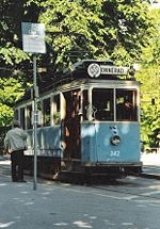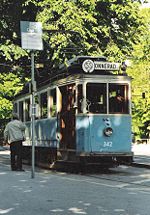
Stockholms Spårvägar
Encyclopedia
AB
Stockholms Spårvägar (SS) (literally Stockholm Tramways), was a company founded in 1915 and owned by the City of Stockholm
to coordinate and operate public transportation within the City. In 1967 the public transport in the entire Stockholm County
was coordinated and the company changed its name to Storstockholms Lokaltrafik
(SL) and its ownership was transferred to the Stockholm County Council.
to operate trams on the streets of Stockholm for 40 years. Largely due to geographic factors, its traffic never extended south of Slussen
, although they had the option to do so. Another company, Stockholms Södra Spårvägsaktiebolag (literally Stockholm's Southern Tramway Company) (SSB) was started to provide tramway traffic on Södermalm
.
The city-owned AB Stockholms Spårvägar was created in 1915 with the aim to coordinate and making the two separate networks more efficient. The SNS network was taken over in 1917 and SSB would follow in 1918. Although the two networks had merged they would not be connected until 1922.
The opening of Västerbron
in 1935 caused a major rework of the tram and bus lines when passage through Gamla Stan
no longer was mandatory when travelling from Södermalm to Kungsholmen
. The first underground parts of the Stockholm Metro
opened in 1933 on the stretch from Skanstull
to Slussen
, although it would be trafficked by suburban trams gaining electricity from overhead wires until special metro vehicles was introduced in 1950 whch collected its power from a third rail
.
In addition to trams, motorbuses and the metro
, SS once operated a large trolleybus
system from 1941 until 1964. The Stockholm City Council decided in 1957 to suspend the tramway and the last five lines (4, 6, 7, 8 and 10) that remained in the City Centre
was closed in conjunction with the switch to right-hand side traffic
in September 1967.
The company changed its name from January 1 1967 to AB Storstockholms Lokaltrafik
and is today responsible for public transport in Stockholm County
.
 In 1987 a new company with the name Stockholms Spårvägar was created by members of the Swedish Tramway Society to take care of the traffic on the then forthcoming Djurgården line
In 1987 a new company with the name Stockholms Spårvägar was created by members of the Swedish Tramway Society to take care of the traffic on the then forthcoming Djurgården line
. Since its 1991 opening the company runs the partially re-opened line to the island of Djurgården in central Stockholm
. The majority of the personnel consist of voluntary enthusiasts receiving no pay, but there are a handful of employees for technical maintenance and administration.
Aktiebolag
Aktiebolag is the Swedish term for "limited company" or "corporation". When used in company names, it is abbreviated "AB" or "Ab"...
Stockholms Spårvägar (SS) (literally Stockholm Tramways), was a company founded in 1915 and owned by the City of Stockholm
Stockholm
Stockholm is the capital and the largest city of Sweden and constitutes the most populated urban area in Scandinavia. Stockholm is the most populous city in Sweden, with a population of 851,155 in the municipality , 1.37 million in the urban area , and around 2.1 million in the metropolitan area...
to coordinate and operate public transportation within the City. In 1967 the public transport in the entire Stockholm County
Stockholm County
Stockholm County is a county or län on the Baltic sea coast of Sweden. It borders Uppsala County and Södermanland County. It also borders Mälaren and the Baltic Sea. The city of Stockholm is the capital of Sweden. Stockholm County is divided by the historic provinces of Uppland and Södermanland...
was coordinated and the company changed its name to Storstockholms Lokaltrafik
Storstockholms Lokaltrafik
Storstockholms Lokaltrafik AB, , commonly referred to as SL, is the organisation running all of the land based public transport systems in Stockholm County....
(SL) and its ownership was transferred to the Stockholm County Council.
Overview
Traffic with Horse drawn trams began in 1877 with the privately owned Stockholms Nya Spårvägsaktiebolag (literally Stockholm's New Tramway Company) (SNS) and it gained a concessionConcession (contract)
A concession is a business operated under a contract or license associated with a degree of exclusivity in business within a certain geographical area. For example, sports arenas or public parks may have concession stands. Many department stores contain numerous concessions operated by other...
to operate trams on the streets of Stockholm for 40 years. Largely due to geographic factors, its traffic never extended south of Slussen
Slussen
Slussen is an area of central Stockholm, connecting Södermalm and Gamla stan. The area is named after the locks between Lake Mälaren and the Baltic Sea. The locks themselves allow passage between these two bodies of water...
, although they had the option to do so. Another company, Stockholms Södra Spårvägsaktiebolag (literally Stockholm's Southern Tramway Company) (SSB) was started to provide tramway traffic on Södermalm
Södermalm
Södermalm, often shortened to "Söder", is a district in central Stockholm. It covers the large island formerly called "Åsön". With a population of 99,685, it is one of the most densely populated districts of Scandinavia...
.
The city-owned AB Stockholms Spårvägar was created in 1915 with the aim to coordinate and making the two separate networks more efficient. The SNS network was taken over in 1917 and SSB would follow in 1918. Although the two networks had merged they would not be connected until 1922.
The opening of Västerbron
Västerbron
Västerbron is an arch bridge in central Stockholm, Sweden. With a total length exceeding 600 m, 340 m of which stretches over water, it is one of the major bridges in Stockholm, offering one of the most panoramic views of the central part of the city centering on Gamla stan, the old town...
in 1935 caused a major rework of the tram and bus lines when passage through Gamla Stan
Gamla stan
Gamla stan , until 1980 officially Staden mellan broarna , is the old town of Stockholm, Sweden. Gamla stan consists primarily of the island Stadsholmen. The surrounding islets Riddarholmen, Helgeandsholmen, and Strömsborg are officially part of, but not colloquially included in, Gamla stan...
no longer was mandatory when travelling from Södermalm to Kungsholmen
Kungsholmen
Kungsholmen is an island in Lake Mälaren in Sweden, part of Stockholm City. It is situated north of Riddarfjärden and considered part of the historical province Uppland....
. The first underground parts of the Stockholm Metro
Stockholm Metro
The Stockholm Metro is a metro system in Stockholm, Sweden. The first line opened in 1950, and today the system has 100 stations in use, of which 47 are underground and 53 above ground. There are seven lines numbered from 10 to 19, in three groups identified by a color: the Green, Red and Blue lines...
opened in 1933 on the stretch from Skanstull
Skanstull
Skanstull is an area in Södermalm in Stockholm. Skanstull connects the traffic between the inner city and the south parts of Stockholm and its suburbs. Skanstull was originally the city’s southern toll station, but the toll station was removed in 1857....
to Slussen
Slussen
Slussen is an area of central Stockholm, connecting Södermalm and Gamla stan. The area is named after the locks between Lake Mälaren and the Baltic Sea. The locks themselves allow passage between these two bodies of water...
, although it would be trafficked by suburban trams gaining electricity from overhead wires until special metro vehicles was introduced in 1950 whch collected its power from a third rail
Third rail
A third rail is a method of providing electric power to a railway train, through a semi-continuous rigid conductor placed alongside or between the rails of a railway track. It is used typically in a mass transit or rapid transit system, which has alignments in its own corridors, fully or almost...
.
In addition to trams, motorbuses and the metro
Stockholm Metro
The Stockholm Metro is a metro system in Stockholm, Sweden. The first line opened in 1950, and today the system has 100 stations in use, of which 47 are underground and 53 above ground. There are seven lines numbered from 10 to 19, in three groups identified by a color: the Green, Red and Blue lines...
, SS once operated a large trolleybus
Trolleybus
A trolleybus is an electric bus that draws its electricity from overhead wires using spring-loaded trolley poles. Two wires and poles are required to complete the electrical circuit...
system from 1941 until 1964. The Stockholm City Council decided in 1957 to suspend the tramway and the last five lines (4, 6, 7, 8 and 10) that remained in the City Centre
Stockholm City Centre
Stockholm City Centre is the city centre of Stockholm in Sweden. The entire city of Stockholm is also the centre of the Stockholm Metropolitan Area....
was closed in conjunction with the switch to right-hand side traffic
Dagen H
Dagen H , today mostly called "Högertrafikomläggningen" , was the day, 3 September 1967, on which traffic in Sweden switched from driving on the left-hand side of the road to the right...
in September 1967.
The company changed its name from January 1 1967 to AB Storstockholms Lokaltrafik
Storstockholms Lokaltrafik
Storstockholms Lokaltrafik AB, , commonly referred to as SL, is the organisation running all of the land based public transport systems in Stockholm County....
and is today responsible for public transport in Stockholm County
Stockholm County
Stockholm County is a county or län on the Baltic sea coast of Sweden. It borders Uppsala County and Södermanland County. It also borders Mälaren and the Baltic Sea. The city of Stockholm is the capital of Sweden. Stockholm County is divided by the historic provinces of Uppland and Södermanland...
.
The new SS

Djurgården line
Djurgårdslinjen is a heritage tramway with line number 7, running between Norrmalmstorg and Waldemarsudde in Stockholm, Sweden.-History:The line, along with almost every other tram line in Stockholm, was withdrawn in conjunction to the switch to right-hand side traffic in 1967, but was restored as...
. Since its 1991 opening the company runs the partially re-opened line to the island of Djurgården in central Stockholm
Stockholm
Stockholm is the capital and the largest city of Sweden and constitutes the most populated urban area in Scandinavia. Stockholm is the most populous city in Sweden, with a population of 851,155 in the municipality , 1.37 million in the urban area , and around 2.1 million in the metropolitan area...
. The majority of the personnel consist of voluntary enthusiasts receiving no pay, but there are a handful of employees for technical maintenance and administration.

